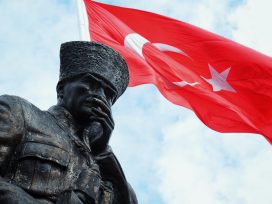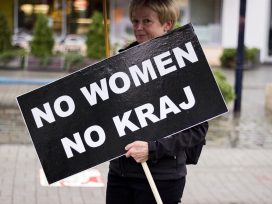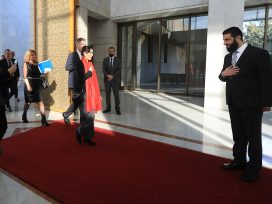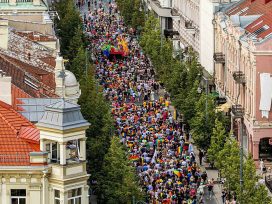In 2018, the centenary of Poland’s independence coincided with another historical moment – the one hundredth anniversary of Polish women’s suffrage. It was decided in Warsaw to commemorate both anniversaries with exhibitions at prestigious art institutions. The National Museum honoured the events with an exhibition entitled ‘Shouting: Poland!’ It explored the Polish experience of the Great War and highlighted the shock of regaining independence as a result of the newly drawn map of Europe. In the Museum of Modern Art, an exhibition entitled ‘Independent: Women and the national discourse’ focused on the historical perspective of women. But although both exhibitions were beautifully arranged and well organized, something was wrong. The first portrayed a country inhabited only by men, in which women were merely illusions. The second showed barely any works by Polish female artists and instead concentrated on metaphors of post-colonialism, slavery and capitalism. It was as if there was nothing of any value at the intersection of femininity and Polishness.
Total amnesia: female sacrifices
It is certainly not the case that women in Poland have not created noteworthy critical or political art. It turned out that the works and their creators had been swept up in ‘total amnesia’. In the absence of systematic reflection and discursive remembrance of women’s resistance in Poland, rebellion occurs as if it is always starting anew; rather than using undeveloped local narrative methods, it refers to models borrowed from the outside and mediated by western centres of thought. This curious tangle of tensions left many viewers unsatisfied: women could be understood here as the victims of the exclusion and violence of political discourse, and their power could only be found in the negation of eliminating symbolism and the exposure of impossible agency.
In fact, the political tension around women’s rights is the most important feature of the Polish transformation. The transformation – understood in terms of the rights of the individual, autonomous subjectivity and civil liberties, particularly relating to control over one’s own body – has been founded by two main gestures: bringing religion into schools and banning abortion, which was fully available during the 42 years of the Polish People’s Republic (1947–1989). The sacrificing of women’s rights ‘on the altar’ of the non-aggression pact with the church, which was an important social actor in the fight for democracy under communism, became a structural feature of Polish modernization. As argued by cultural analysts such as Jan Sowa and Przemysław Czapliński, this modernization tends to be understood in the sense of infrastructural or technological improvements, without being accompanied by a progressive understanding of human rights (especially the rights of women and sexual minorities). The liberty of the individual succumbs to a specific atrophy – in terms of morality and existentiality, what is individual must yield to pressure from the community, and this pressure, strengthened by a conservative ideology founded on religion, wants above all to be constructed in a reactionary and conservative manner. Contemporary Polish togetherness is exclusionary and compensatory in nature, with its ideal based on the traditionally understood notion of the family, which emphasizes the reproductive and subordinate role of women.
The political advancement of the far right that has been observed in recent years is the culmination of this process. In this sense, the entire transformation period should be recognized as a time of amplified crisis of Polish social and national identity, which had to be reconstructed within the situation of regained freedom, in the framework of its paradoxes and tensions. Attacking the already limited rights of women, who were the first victims of changes in the system, appears to have been a natural consequence. Modernization is accompanied by anti-modernism and moral decline, associated with an incomplete understanding of individual growth.
Women occupy the most contradictory place in this phenomenon. The sacrifices that served to consolidate the new order also pose the greatest threat. In her analysis of Polish nationalism, Agnieszka Graff, one of Poland’s best-known feminists, wrote about rare cases of the restitution of female subjectivity in Polish history, which always occurs in ‘exceptional’ laws. ‘The appearance of “female warriors” … – and in the Polish public discourse this narrative applies, inter alia, to female participants of the Warsaw Uprising, as well as the heroines of Solidarity – constitutes … a kind of suspension of the rules of history, a sign that the community has found itself in a state of particular danger.’ Entering the resistance movement ‘means for women the suspension of the interests of their own gender (claims related to equality) … When the period of struggle ends, women are sent back to “their” place.’ The curse of Poland’s complicated, martyrological history is the ‘then you’ mechanism underlying its resistance movements, which allowed women to be involved in the struggle without their empowerment: first independence, then you; first a strong state, then you; first victory (in the Second World War), then you; first socialism, then you; and finally: first capitalism… Equality has always been postponed this way. Contemporary Poland is a country in which the struggle for modernity takes place at the expense of women.
The ‘Black Monday’ protests
The conservative-nationalist party Law and Justice (PiS) came to power in Poland in 2015. The universal law began to take effect that dictates that where there is a crisis of collective identity or violent political change, ‘nationalism entails more control over women’. In 2015, however, Poland was not experiencing an identity crisis, nor was it in a state of war or increased combat readiness. Rather, the new Polish government, replaying events from the early 1990s, began to provoke a political crisis by fighting women’s organizations and undermining the Istanbul Convention on preventing violence against women and domestic violence. The hard rule of the Polish-Polish war against women was being exacerbated in the hands of right-wing fundamentalists. Finally, in spring 2016, the prime minister, Beata Szydło, announced her support for a civic initiative connected to the Catholic church to tighten the already restrictive laws on abortion.
The political crisis and the resistance movement to which it gave rise now existed in parallel with a mass movement by women in protest at the new laws. In 2016, for the first time in Polish history and on an unprecedented scale, Polish women took to the streets in defence of their rights, to demonstrate against the proposal for a radical ban on abortion. It was raining on the first day of the protest, and the streets of Polish cities and towns swarmed with umbrellas. The symbol of the umbrella immediately dominated the aesthetics of the protest, and tallies with an important motif in the history of Polish women’s struggle for their rights. The rustling of umbrellas in the wind recalled the clattering sounds made by the Suffragettes just over a century ago; according to legend, they used their umbrellas – fashion accessories at the time – to knock on the windows of President Józef Piłsudski’s villa, demanding that he make a quick decision and grant them the vote. However, can we be sure that the umbrellas of today will have the same impact?
Not only did the scale of the Black Monday Protests surprise the radical right, prompting them to back down from the new law. The protests were a phenomenon whose consequences, in terms of its duration in the history of the collectivity, are not fully known. This can be compared to early Solidarity – before the movement descended into a political battle at the Round Table in 1989, and before it became the anti-feminist conservative social movement it is today. Back then, it was a spontaneous, grassroots mass uprising uniting one million male and female members (though forgotten and ignored, women played a significant underground role). Will a second gesture on such a huge scale signify liberation for women in Poland? It should be noted that the Black Monday Protests were not so much progressive as they were conservative. Women took to the streets to defend the status quo – the right to abortion, allowed only in three restrictive situations, and rarely observed by Polish gynaecologists citing a conscience clause; a law that is constantly subjected to medical and ideological manipulation.
The foundation of the festering ideological war is thus revealed: the prohibition of abortion is part of the fight against female sexuality and women in general. The underlying weakness of Polish feminism is also highlighted: its inability to develop a central narrative that is be able to reach the political mainstream or society as a whole. In 2016, after the rejection of the ‘Let’s Save Women’ Act, which was supposed to liberalize access to abortion, the opposition cited the Black Monday Protests as a movement that would overthrow the PiS government. There were chants of ‘Beata, what a shame, women will end your reign!’, despite the fact that the demonstrations were focused on the restoral of women’s rights and not on a change of power. At the beginning of 2018, following another rejection of the act, it emerged that a large number of opposition MPs had also voted against liberalization (MPs from parties which, just like PiS, were heirs to the Solidarity movement). The reaction on the streets was rage, with activists reading out a ‘list of shame’ containing the names of MPs who had voted against rights to abortion.
In response, Grzegorz Schetyna, leader of the largest opposition party, Civic Platform (PO), went all out to win Barbara Nowacka – the figurehead of the protests – as a coalition partner. Only a few weeks after Nowacka announced her decision to join the PO, Schetyna revealed that he would not be supporting her abortion demands and that the talks had not revolved around this subject. The leader of the PO parliamentary group in the Sejm, Sławomir Neumann, added on behalf of the party: ‘We defend Polish women, but we will not succumb to extremists from one side or the other.’
By December 2018, the grassroots women’s movement in Poland was slowly disintegrating. The structures which the movement had developed across the country had helped to support the new movement of the homosexual mayor of Słupsk, Robert Biedroń. Based on the model of French president Macron, Biedroń wants to develop communication across divisions and salvage participatory democracy. Another faction of the women’s movement, following Nowacka, was absorbed into the Civic Platform. Other activists turned to local and grassroots work. Jarosław Kaczyński, the leader of PiS and de facto ruler of Poland, announced that discussions on abortion would be deferred at least until the end of his term (autumn 2019). The fighting was over, and women were returned to their place.
Sleeping with the enemy
Let us end with the voice of Polish art created by women, which now takes on the challenge of responding to the constraints of ‘women’s sacrifice’ and the political exclusion of women on the Polish road to modernity. But first, a reminder of the extraordinary scenes from the nationalist-fascist demonstration that took place on National Independence Day, 11 November 2017, which gathered around 60,000 extremists from Poland and all across Europe (the biggest fascist demonstration since the Second World War). A dozen women sitting on the streets in Warsaw were surrounded by middle-aged male protestors wearing ‘football hooligan’ red-and-white scarves. There were insults, kicking and prodding – the women were treated with contempt and hatred, as a foreign element in this display of masculine, macho white supremacy. A seven-metre banner unfurled by the protesters proclaimed: ‘Women against fascism’.
In the pictures that circulated globally, the Polish capital burned with flaming torches and firecrackers under the red-and-white flag. Against the cloudy autumn backdrop, the white lights of the bright city contrasted with the red smoke. The women on the street – embroiled in the red-and-white symbolism, entangled in the snares of masculine right-wing patriotism, the ‘hooligan’ scarf tightening around their necks – seemed to allude to the exhibition, ‘Poles, patriots, rebels, women’, on display at the Arsenał City Gallery in Poznań. It opened in September 2017 to celebrate the nationwide Congress of Women (currently the largest social movement in Poland!), and was dedicated to the Black Monday Protests in Polish women’s art. The works on display show the desperation and ambiguity of contemporary Polish women’s relation to Polishness. The female sabotage of national symbols on the streets of Warsaw was like a political and civic project that had moved from the gallery walls to the street.
The desperation of the female protagonists of these protests, transformed into a strong political symbol, catches the attention in the same way as the new generation of female Polish artists displayed at the exhibition in Poznań. Karolina Mełnicka’s white-and-red burka at the stadium (‘Polish burka’, 2013), Lilianna Piskorska’s photograph of sleeping with a ‘real Pole’ in bedding decorated with the national emblem (‘Self-portrait with a borrowed man, a.k.a. I’m Polish so I have Polish duties’, 2016), Agata Zbylut’s ball gown made from football scarves (‘Caviar patriot’, 2015), Iwona Demko’s dream of the Black Monday Protests, made from raised skirts with vagina manikins outside the Cloth Hall in Kraków (the banner reading ‘408,223 skirt lifts, or My dream of the Black Monday Protests’, 2016), Marta Frej’s memes affirming women’s patriotic activism (‘I took part in the Black Monday Protests because…’, 2017), and the Poznań Witches’ Choir (a women’s performative and musical group) chanting about revolution – these are the symbolic elements of the political project of women’s activism, which also sounded loud and clear during the fascist Independence Day March. We have deliberately listed them in a particular gradation – from a description of depression to one of rebellion – to emphasize the revolutionary tension which is harboured here.
The subject of the Polish–Polish war against women was a key theme, and the works displayed at the exhibition were surprisingly coherent. For the most part, they concerned identity – questioning the imaginary derivatives of the fundamental model of the Polish woman anchored in the family and relationships, whose prototype is the basic national model of Polish femininity, the ‘Polish Mother’. This is a woman who is not free, because she has placed her subjectivity, her senses and her bodily integrity on the altar of the homeland. Even if the contemporary Polish woman is freeing herself, there is a whole subconscious matrix pulling her into a net of these entanglements.
In the works of the artists displayed, this entanglement was transferred to the ubiquitous red-and-white, the national colours. The problem of the Polish woman is the Polish man – he is the depositary of the national colours, and his most exaggerated and vulgar version is that of the ‘hooligan’ or ‘thug’. It is mainly men who are susceptible to the martyrological ideology of national pride and self-contempt. Strongly militarized and based on a paradigm of physical violence, this symbolic proposition is mainly addressed to them. Because this phenomenon is occurring on such a large scale, it has a direct effect on women’s lives. Part of the title of the exhibition – ‘patriots’ – is a hypothesis in this context. The female Polish patriot today is total subversion in the face of the dominance of the Polish male patriot, who has used the national colours to create a folklore based on his own reaction and fearful compensation for his inability to confront the changing roles of women.
It seems that art (created by women) has played a vital role in recording the conservative social revolution, which has been strengthened by the rule of PiS. It has devoted a lot of attention to the endangering of personal freedom and the idea that nowadays, Polish women who are patriots must be rebels. It should be emphasized that these works demonstrate a certain repetitiveness, a staged stupor, simultaneous excess and understatement – essentially, Poland is represented as obvious (even physical) discomfort. Adding to this the latent suffering visible in these works, suffering which relates to both the person and the woman, as well as the citizen and the woman, we end up with a script for rebellion, an archaeology of female anger, which came to the fore in the Black Monday Protests, when women won back the public space that had renounced them. The Black Monday Protests, seen through the eyes of art, grew out of women’s desperation, their sense of abandonment and solitude.
But this quiet, underground, symbolic and literal revolution is continuing, both in the galleries and in the streets. The riskiness of introducing the Black Monday Protests into the framework of the gallery, meaning openness to fluidly emerging meanings, questioning and undermining our weaknesses, is also a possible harbinger of symbolic empowerment. The stakes are high – art as an area of political debate can expose restrictions, creating questions and alternatives which have the power to redefine the world. And we can only do this from the position of a self-aware, strong, symbolic narrative that will be able to influence this debate in a significant way, creating narrative shocks, breaches and fissures, and opening up new inclusive perspectives. The question remains: how to transform this rebellion, not into an endless re-beginning, but into a wave that will be capable of leading us towards new, strong and politically resilient perspectives?







